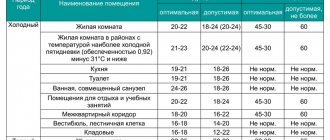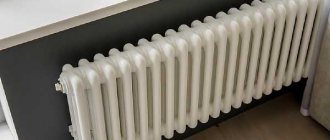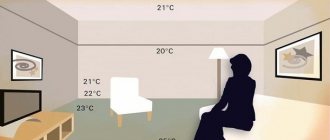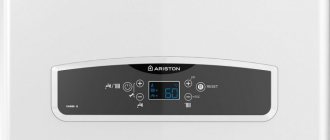In our apartments, the microclimate is formed by several factors and room temperature is its most significant part. Thermal comfort of household members is individual, depending on their gender and age. However, the difference in heat needs between members of the same family is small and amounts to 2-3°C, allowed by SanPiN standards.
We will tell you how to determine the optimal temperature and how excessive cooling or overheating affects people’s well-being. In addition, we will outline the parameters of a comfortable microclimate, and also provide effective ways to maintain normal temperature conditions in the room.
What determines the optimal temperature of an apartment?
The temperature regimes that provide comfort to households depend on the climatic location of the home. In the southern regions and in the northern areas, as well as in western and eastern latitudes, the normal house temperature will be different.
As for countries, their climate is also different. And since the components of climate, in addition to temperature, are atmospheric pressure along with air humidity, the acceptable thermal range is set by them together.
For example, the humidity of the home’s atmosphere: the high humidity characteristic of hot countries requires higher values for the normal temperature of the home, because heat-intensive, moisture-saturated air actively takes away the heat of human bodies.
Temperature formation
The temperature inside a home changes due to the periodic change of seasons. Summer is always warmer than winter. In a temperate climate zone, the acceptable room temperature in the warm season will be +22...+25°C, in the cold season - +19...+22°C. Considering the duration of exposure, the seasonal temperature difference, although apparently small, still matters.
Placing split systems in the main rooms of the apartment will provide the necessary atmospheric parameters during the warm season. Household air conditioners are not capable of fully heating a home at low winter temperatures.
Finally, a comfortable temperature for a person in various rooms of an apartment is associated with his gender and age characteristics.
Let us note right away that personal preferences for one or another temperature regime do not mean health benefits. Excessive overheating, for example, refusal of air conditioning in hot weather, or hypothermia of a room due to a window open in cold weather, certainly harms the human body.
The maintained optimal air temperature in the room must correspond to the temperature needs of household members of different genders and ages. For example, for women, a comfortable home atmosphere will be 2-3°C higher than for men - women are more thermophilic.
Young children need a room with a stable temperature in the range of +20°C...+23°C. Temperature changes are especially difficult to tolerate for an infant, whose body is not yet capable of full (adult) thermoregulation.
For the room where the baby is located, it is extremely important to maintain a stable temperature level of +23°C...+24°C all year round, since a small child overheats and freezes much faster than adults.
Dangers of cold rooms
In medical terminology, hypothermia is called hypothermia - a condition that causes profound harm to the human body, contributing to the development of diseases of the nervous system and respiratory diseases.
In attempts to compensate for heat loss, the human body concentrates heat supply on the organs of the body and head. Therefore, warming the extremities is necessary.
Once in a cold atmosphere, our body strives to block hypothermia by using energy resources and sharply increasing heat transfer. This works when exposed to the cold for short periods of time.
However, with prolonged exposure to low temperatures, the body’s resources to compensate for heat loss are insufficient and the body cools below +36°C.
A characteristic sign of hypothermia is shivering, stimulated by the body in response to cold - excessive muscle activity produces heat. Hands and feet become cold because the blood vessels in them contract to reduce blood flow and reduce overall body cooling.
A decrease in body temperature below +35°C will cause a slowdown in the heart rate, breathing and weaken mental activity.
Hypothermia is especially dangerous for young children, whose bodies are physically smaller than adults and are not able to quickly produce heat. A child's body suffers from cold much more deeply than an adult.
Risks of excessively warm rooms
A hot room atmosphere creates ideal conditions for the development of pathogens that cause infectious diseases, primarily skin and intestinal diseases.
Being under a direct flow of conditioned air cooled below +22°C will result in thermal shock to the body. You cannot direct the air generated by the air conditioner towards yourself.
Hyperthermia has a detrimental effect on the human body, especially on the heart. In the hot microclimate of the room, a person sweats, which is why he loses a significant amount of moisture.
The blood thickens and becomes “heavy,” requiring the heart to work harder to pump it into the blood vessels. In case of cardiovascular diseases, such loads will be extremely heavy.
Dehydration, caused by the body's desire to balance external and internal temperatures, worsens the water and electrolyte balance of the human body and weakens the nervous system.
An overly warm bedroom atmosphere contributes to the development of insomnia by interfering with normal body thermoregulation. In a moderately cool microclimate, the body quickly moves into the deep phase of sleep, redistributing internal heat from the center of the body to the extremities.
Factors affecting temperature
You can find out what room temperature should be in an apartment or private house in GOST 1.5-2001. But this norm largely depends on factors influencing the final indicators. There are several conditions that can change it:
- Climatic features. All countries are conventionally divided into northern and southern. Each of them has its own concepts of what the temperature in the room should be, since climatic conditions are determined not only by air temperature. They include average humidity, precipitation, and atmospheric pressure. Particular attention is paid to sunny days throughout the year, since in some localities this indicator is quite low. Based on all the data, regulatory documents are drawn up.
- Seasons. There is no need to explain at length that seasonal characteristics also play a role in shaping the indoor microclimate. In summer, the temperature is high, the air becomes dry, in the fall there is increased humidity, in winter the indicators decrease somewhat, regardless of the quality of heating. Optimal numbers can be observed in the spring, especially when the season was not very rainy.
- The human factor is also worth considering, since the normal temperature in the room will be different for everyone. Women freeze more often than men, so for them the norm is 2-3 degrees higher. Some people feel quite comfortable on the hottest summer day, while others in winter constantly complain about the stuffiness and open the windows.
- The materials from which the housing is built also play a role. Apartment buildings are usually built from special slabs that quickly heat up and cool down. A private house can be built from brick, cinder block or other materials, and the rate of heat accumulation and consumption in them is different.
Elderly people and children also sense temperature differently, and the norms are different for them. An optimal microclimate is especially important for infants.
Apartment temperature standards
State standards for seasonal temperature are established in GOST 30494 and SanPiN 2.1.2.2645-10. The optimal temperature conditions for the living rooms of an apartment according to the above-mentioned state standards is the range of +20...+22°C in winter and +22...+25°C in summer.
The specified temperature ranges are mandatory for the microclimate of residential buildings in the Russian Federation. But it is better to avoid standard temperature minimums of the cold season and maximums of the warm months if there is a lack of health (+)
For technical rooms, in any annual season, temperatures are defined in the range of +19...+21°C for the bathroom and kitchen, +24°...+26°C for the bathroom and +16...+18°C for the pantry.
Understanding the difficulty of maintaining the temperature state of the microclimate within 2-3°C of optimal conditions, the developers of these standards in their text part outlined the permissible ranges of room temperatures, namely:
- living rooms – +18°С…+24°С in winter, +20°С…+28°С in summer;
- kitchen and bathroom – +18°С…+24°С;
- combined bathroom – +18°…+26°С;
- pantry – +12°С…+22°С.
It is obvious that the permissible upper temperature range for non-residential premises, for example, +24°C for a bathroom and kitchen, according to state standards is focused on the warm annual period, and the lower, for example, +12°C for a pantry, is aimed at the cold period.
Comfortable microclimate parameters
Gost standards are largely intended for designers, housing and communal services and judicial procedural departments, since they establish mandatory temperatures for residential premises.
A microclimate is considered comfortable if it allows the human body to maintain a temperature of 36.6 degrees without complications. The “tabular” resulting range will allow you to maintain this body temperature, provided that the body is insulated in winter and water is consumed in summer
However, the full formation of a home microclimate requires attention to the recommendations of experienced doctors and psychologists, and to the individual preferences of household members.
Bedroom . The human body needs sleep not only because of fatigue during the period of wakefulness - to produce the hormone melatonin, which controls the biorhythms of our bodies.
The lack of acceptable conditions for sleep and, accordingly, the hormonal activation of melatonin results in insomnia and a “broken” state - general weakness and headache, slowing down the mental functions of the brain.
For proper rest of adult household members, the temperature in their bedrooms should be maintained in the range of +17°С…+18°С, i.e. The “sleeping” microclimate should be cooler than other living spaces. It is more difficult to fall asleep in a warmer or cooler atmosphere.
Children's room. Its optimal temperature is determined by the age of the child. For a baby, the best is +23°C...+24°C, since the baby’s body is not capable of “adult” thermoregulation. For children over 3 years old, the room temperature will be +21°С…+22°С.
Kitchen room. The operation of household equipment from the usual kitchen set - stove, oven, electric kettle, microwave, hood, etc. - is always accompanied by heat generation. Accordingly, when preparing food, the kitchen atmosphere becomes warmer than in other rooms.
Given the traditionally small size of the kitchen, the heat radiation from kitchen appliances warms it up quite quickly. Therefore, it is enough to maintain the temperature of this room in the range of 18-19°C.
Electric floor heating systems reach maximum heating faster and maintain temperature more accurately than circuits with liquid coolant. And you can’t flood your neighbors with them
Bathroom. Bathing procedures are accompanied by intense saturation of the bathroom atmosphere with moisture, which is why the microclimate of a room with a temperature outside the range of 24-26°C will be uncomfortable.
For other rooms and corridors, the comfortable temperature will be 18-22°C. Temperature differences between apartment rooms should not be more than 2-3 degrees,
In winter, less heat is required, in summer - more. Otherwise, the temperature imbalance between the external environment (street) and living quarters will be stressful for the body.
A sharp change in the temperature of the surrounding space when going outside from the microclimate of the apartment may be followed by hypothermia or overheating of the body, which, as discussed above, is equally bad.
The optimal difference in atmospheric temperatures between the house and the street during the transition between them is 4-5°C. Therefore, you should not overheat the apartment in winter or overcool in summer.
Standards for each room
There are certain standards established by GOST. They describe what comfortable temperature in an apartment or house will help maintain and improve the health of all household members. Indicators of air movement speed and humidity in the living room are also taken into account. The first should not exceed 0.3 m/s, the second - 60%. The temperature for each room should be different:
- In the bedroom of an adult, the temperature must be maintained at +18-19 °C, otherwise the owner of the room often experiences headaches, insomnia, and is distracted and drowsy throughout the day. Overheating is not needed during sleep, so it is better not to turn on the heaters.
- Almost every kitchen contains appliances that generate heat, for example, an oven, stove, kettle, multicooker, etc. That is why it is enough to maintain a temperature of +19 °C in this room to avoid overheating.
- The bathroom should be comfortable not only in terms of equipment, but also have an optimal temperature regime. According to GOST standards, this indicator should not be lower than +24 °C and higher than +26 °C. Smaller numbers will certainly lead to the room becoming damp and unpleasant. It is especially important to follow the rules when there is a small child living in the house.
- For the living room, +20-21 °C is enough for the household to feel comfortable. If there is a wood-burning or electric fireplace in the room, it is allowed to reduce the rate by 1-2 degrees in winter. It is worth noting that the temperature should be the same at the top and bottom of the room.
- The children's room is the most important room in an apartment or house. For a newborn baby, the indicator should be at least +24 °C. For children over 3 years old, +21-22 °C is enough.
- Almost every apartment has a storage room. The temperature in it should not exceed +17 °C. A higher rate will lead to damage to workpieces that are usually stored indoors. In a private house, the pantry has been replaced by a cellar, in which high temperatures are rarely observed.
In other rooms, temperature fluctuations within +18-22 °C are considered normal. It is worth noting that when moving from one room to another, the temperature difference should not be felt.
How to ensure temperature conditions?
The tasks of maintaining the microclimate in the optimal temperature range are divided into two - cooling the atmosphere of rooms in the warm months and heating during the cold season.
The first task can be easily accomplished by air conditioning equipment placed independently in the bedrooms, living room and kitchen. Temperature sensors of single-block and double-block air conditioners (split system) will maintain the set temperature, strictly following user settings.
The gas bellows built into the thermostat reacts to the temperature of the room atmosphere, displacing the spool and controlling the flow of coolant
It is more rational to use inverter climate control technology that can maintain the temperature of the room microclimate gently, without sudden emissions of cold air flows.
Until mid-September, split systems are able to operate for heat even in a temperate climate zone, but as the temperature difference “apartment-street” increases, it will be impossible to use split systems for heating.
The task of maintaining a comfortable atmosphere in the house will shift to heating equipment - central heating radiators and underfloor heating systems.
It is not difficult to control the temperature conditions of the “warm floor” heating complex. Liquid systems are equipped with a thermostatic valve or an automatic pumping and mixing group, which are equally capable of controlling the temperature of the coolant circulating through the circuit built into the floor.
In infrared and electric floors, temperature control is carried out by digital, programmable or electromechanical thermostats. By constantly checking temperature changes against preset thresholds, they turn the system off or on.
Classic apartment heating systems, based on the circulation of hot water through pipes into radiators, also allow temperature control.
It will be necessary to equip the pipe at the coolant input to the radiator with an automatic temperature controller (thermostat) that controls the intensity of hot water supply according to a given parameter.
Note that it is easier to equip a circulation-radiator heating system with battery thermostats if it has a two-pipe design. For a single-pipe circuit, it is necessary to supplement the pipe circuit with a bypass, which creates an outlet channel for the coolant in front of the radiator.











